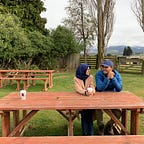Melbourne Urban Travel Time
I’ve been only one week in Melbourne, and I have traveled from Hawthorn to Coburg North.
It seems that it was quite crazy. I got an offer to help a warehouse to remove some stuff and at first, it was at Nunawading. But I got transferred just the night before I started working. I thought, ‘oh, nice, I’ll try to be there. From my GoogleMaps, it will be only an hour using public transport’. My friend told me that it would be much easier if I had a car, but yeeaah… I ignored him. Turns out, it was a real nightmare for me. To get to Coburg from Hawthorn, you must take at least three different train/bus (2 times transit). In the morning, I almost got lost at Parliament station because on the internet the train should have been using Platform 2, but it was actually Platform 1. Lucky me, I asked an officer in the station and was able to catch the train on ti
me. No transit was missed, and I arrived on time. However, it still took me about 1 hour and 15 minutes to get there. The afternoon was a real nightmare. At first, I was waiting for the bus that was heading north (so it was at the west part of the street). I waited there for about 20 minutes before I double checked my GMaps again. When I checked it, it was rerouting to the other side of the street. I was shocked and afraid that the bus was not coming. So, I moved to the other side of the street. When I finally moved, the bus that was coming north passed by me! Oh God! I had to wait for another 20 minutes before catching the bus. When I got to Flinders Street Station, I should take Alamaine train that was heading to Glenferrie. Alas, I let the train pass by me again (in front of my own eyes) just because I thought that it was heading in another direction. In total, the return time travel was about 2 hours for me. I was really exhausted by that time, and curious about the urban travel in Melbourne.
This story is inspired by my all-time data scientist hero, Mba Mona, who has published urban travel conditions in Jakarta.
The method
The travel data in this work is gathered on 24 December 2021, at 02.00 PM from several Local Government Area (LGA) to Melbourne CBD. It is assumed that everybody is heading to Melbourne CBD for simplicity. There are two travel modes included which are by driving and public transport (transit in Google Maps). I took the data from Google Maps using Google Sheets Script Extensions from Labnol. The shapefile was found from diva-gis, in Kerry Halupka’s work in 2020. The granularity of this map is somehow similar to postcode, although they call it LGA. The shapefile is further edited using QGIS to only show Victoria LGAs and connected with the travel duration using Tableau Public.
Note: there are some statements from my friends that are to be confirmed in this work, (1) Melbourne City development is heading east. This is previously confirmed by properties prices that are usually cheaper in the western area and (2) public transport travel duration is quite long compared to personal car.
Let’s check it!
Public transport to driving travel duration ratio
The image above shows the driving to transit speed ratio. For example, the highest ratio, which was obtained by Knox-North-East was more than 4. It means that driving is more than 4 times faster than taking public transport. As far as I can see, there is no ratio data below 1, meaning that owning a car is always the faster option than taking a bus or train. Zero bars are places that just can’t find a nearby public transport (don’t blame me, ask Google Maps, hehe). Unlike Jakarta, for instance, where you can be trapped inside a traffic congestion for hours while seeing the bus or train goes every 15 minutes.
Melbourne is the perfect place to drive a car.
Is the city development heading east?
Let’s see it from two perspectives: driving a car and taking public transport. The first image you see here is the travel duration in hours by driving a car.
As you can see here, Melbourne CBD is located in the small rectangular area in the center of the map. Although the difference between east and west is not that much, we can see that the eastern part of Melbourne is slightly brighter than the western part. If this map isn’t yet that obvious, let’s check the public transport map.
In this map, it is more obvious that the western part is quite different from the eastern part. You can see that with the same distance, for instance Melton Bal compared to Manningham or Nunawading, traveling to Melbourne CBD from the western part of Melbourne takes more time compared to the eastern part. Except for Seville, Nillumbik Bal, Dandenongs, and other further eastern areas. It is also obvious that the Wyndham area in the west can’t find the public transport route to the city (again, I only fetch this data from Google Maps, don’t blame me, haha). Therefore, we can agree once again that my friend’s information is true.
I hope this information can help your travel or stay in Melbourne. Stay connected with me for more stories!
Sincerely,
Andreas
